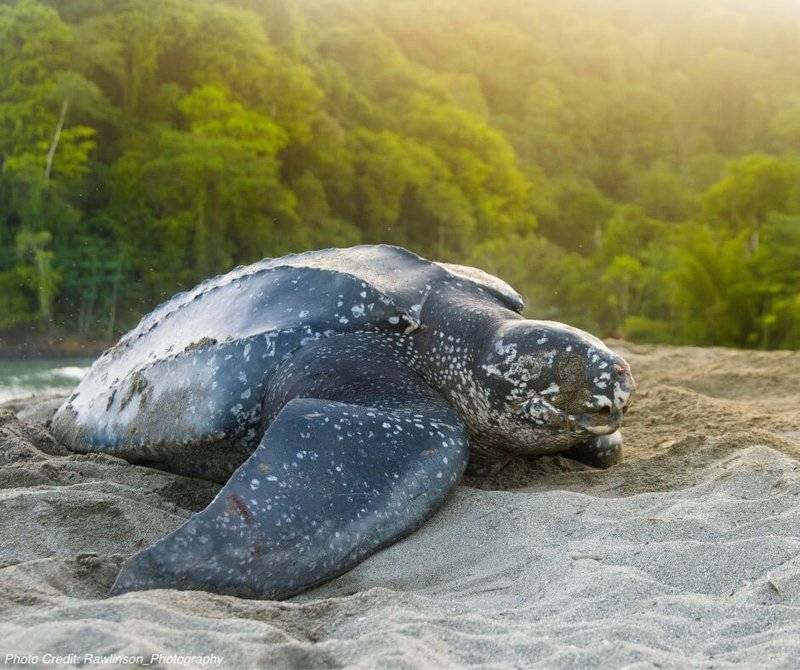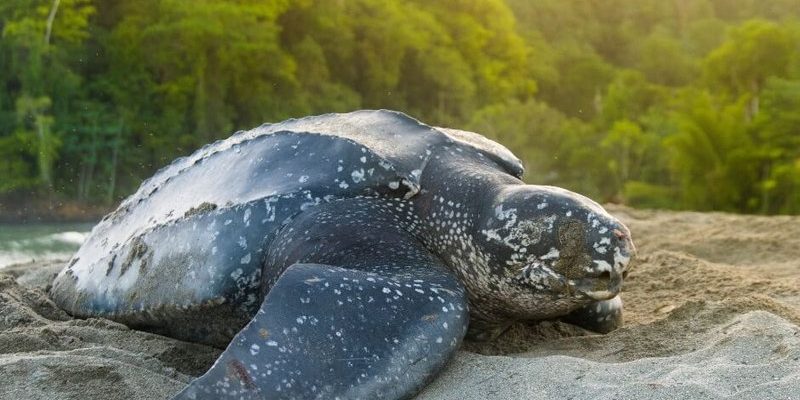
Leatherback turtles are unlike any other! Their shells are soft rather than hard, making them more flexible and adaptable to the vast ocean environments they inhabit. These magnificent creatures also have a diet primarily consisting of jellyfish, which can be a challenge to find due to their vast migrations. But here’s the thing: they’re built to thrive in these conditions. Let’s dive into the world of leatherback turtles and explore some amazing facts about them that’ll make you appreciate these gentle giants even more.
1. Unique Shell Structure
Most turtles have hard, bony shells that protect them, but the leatherback turtle breaks the mold. Instead of a hard shell, its exterior is covered with a leathery skin, giving it a more flexible form. This shell, known as a carapace, is actually made up of a layer of tough, oily skin with small bones underneath. Why is this important? The softness of their shell allows them to dive deeper than other turtles, reaching depths of over 4,000 feet! Imagine them navigating through the dark waters, swimming effortlessly where most creatures cannot go.
This unique structure also aids in thermoregulation. Leatherbacks are capable of maintaining their body temperature even in cold ocean waters, thanks to their insulating layer of fat and the unique structure of their bodies. This adaptation allows them to thrive in various environments, from warm tropical waters to the chilly coasts of the North Atlantic. Isn’t that fascinating?
2. Habitat and Migration
The leatherback turtle is a global traveler. You can find them in oceans around the world, from the Arctic to the Antarctic, but they primarily love the open sea. What’s truly remarkable is their migratory patterns. Some leatherbacks travel thousands of miles between their feeding and nesting grounds. For example, they may nest on a tropical beach in Costa Rica and then swim all the way up to Canada to feed on jellyfish!
This long-distance migration is not just a leisurely swim. It’s a vital part of their life cycle. They navigate using the Earth’s magnetic fields and the position of the sun. It’s like having a built-in GPS! This ability often leads them to areas where food is plentiful, ensuring they have enough energy for their long journeys. You might wonder how they manage such journeys—it’s all part of their incredible instinct and adaptability.
3. Diet and Feeding Habits
Leatherback turtles have a fascinating diet primarily consisting of jellyfish. This choice might seem odd, but there’s a good reason for it. Their bodies have evolved to handle the stinging tentacles of jellyfish, and they can consume large quantities. A single adult leatherback can eat up to 73,000 jellyfish in one season! That’s a whole lot of jellies!
But here’s the catch: their feeding habits can lead to issues. Sometimes, leatherbacks accidentally consume plastic bags, mistaking them for jellyfish. This can be harmful and even fatal, as their bodies can’t digest plastic. In recent years, conservation efforts have focused on reducing ocean pollution to protect these magnificent creatures and their habitats. It’s a vital reminder of how connected we all are to marine life and the importance of keeping our oceans clean.
4. Nesting Behavior
Leatherback turtles are also unique when it comes to nesting. Female leatherbacks return to the beaches where they were born to lay their eggs, a journey that can take them years to accomplish. They come ashore during the nesting season, which varies depending on their location. Typically, they lay about 80 to 100 eggs per nest, and they may nest multiple times in a season.
The nesting process is a sight to behold. After digging a hole with her flippers, the mother turtle lays her eggs and covers them back up before heading back to the ocean. The eggs incubate in the warm sand for about 60 days, and then the hatchlings make their journey to the sea. Unfortunately, many face challenges from predators and habitat destruction, making their survival a tough road. Understanding their nesting habits can help conservationists protect these amazing creatures and their future.
5. Longevity and Lifespan
You might be surprised to learn that leatherback turtles can live a long time—some estimates suggest they can reach up to 50 years or more! However, determining their exact age can be tricky since they don’t have rings like trees do. Researchers often use genetic analysis or size estimation to gauge their age.
Their longevity often comes with wisdom; older turtles usually have better navigation skills and feeding strategies, allowing them to thrive in the ocean’s vast expanses. However, with the challenges they face, including habitat loss and fishing practices, their lifespan can be impacted. Protecting the oceans and their ecosystems is crucial to ensure these gentle giants can live long, healthy lives.
6. Conservation Status
Sadly, leatherback turtles are classified as vulnerable by the International Union for Conservation of Nature (IUCN). Their populations have been declining due to various factors, including habitat loss, climate change, and entanglement in fishing gear. Conservation efforts are underway in many countries to protect nesting beaches and reduce plastic waste in the oceans.
Organizations around the globe are working hard to raise awareness and involve local communities in conservation programs. Initiatives like beach clean-ups and monitoring nesting sites are vital for safeguarding their future. Each small effort counts, and together, we can make a difference in the lives of these magnificent creatures.
7. Incredible Adaptations
Leatherbacks are full of surprises when it comes to their adaptations. Besides their unique shell structure and ability to maintain body heat, they have specialized flippers that allow them to swim efficiently for long distances. Their front flippers can reach lengths of about 8 feet, helping them navigate through the ocean currents with ease.
Another fascinating adaptation is their ability to dive for long periods, sometimes up to 85 minutes! This is particularly important when hunting for prey. Their bodies are designed to withstand the intense pressure found at great depths, allowing them to forage for food that other turtles might not reach. How amazing is it that evolution has shaped these creatures into such skilled ocean travelers?
8. Cultural Significance
Leatherback turtles also hold significance in various cultures. In some coastal communities, they are seen as symbols of perseverance and strength. Many indigenous peoples honor these turtles for their long migrations and resilience in the face of challenges. Additionally, in modern times, they have become icons for marine conservation efforts, drawing attention to the urgent need to protect our oceans and their inhabitants.
Efforts to promote awareness about leatherbacks often lead to educational programs in schools and communities, emphasizing the importance of respecting marine life. This cultural significance helps foster a sense of responsibility in protecting these magnificent animals for future generations.
Leatherback turtles are not just fascinating creatures; they are vital members of our ocean ecosystems. From their unique soft shells to their incredible migration patterns, these gentle giants remind us of the importance of protecting our oceans. With their vulnerabilities and challenges, the future of leatherbacks depends on concerted efforts to conserve their habitats and reduce human impacts.
So next time you hear about leatherback turtles, think of their incredible journey and the role we play in their survival. It’s a shared responsibility that calls for awareness, action, and a commitment to keeping our oceans clean and healthy. These remarkable creatures deserve our respect and protection, and by learning more about them, we can help ensure they thrive for generations to come.

